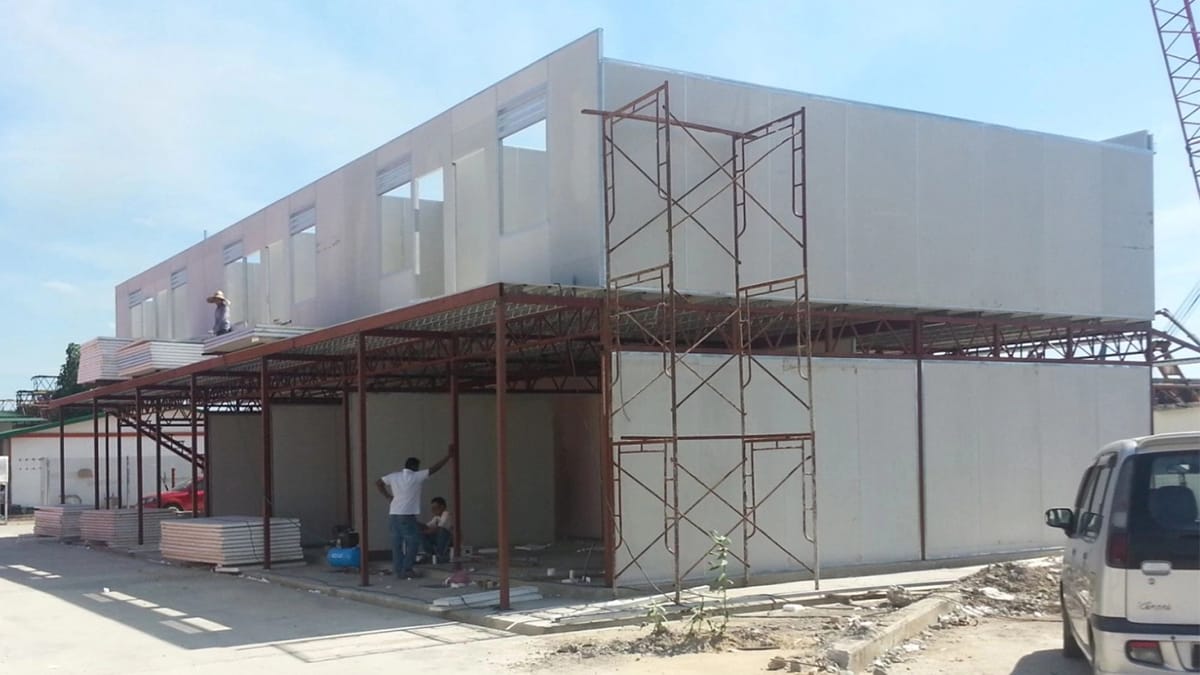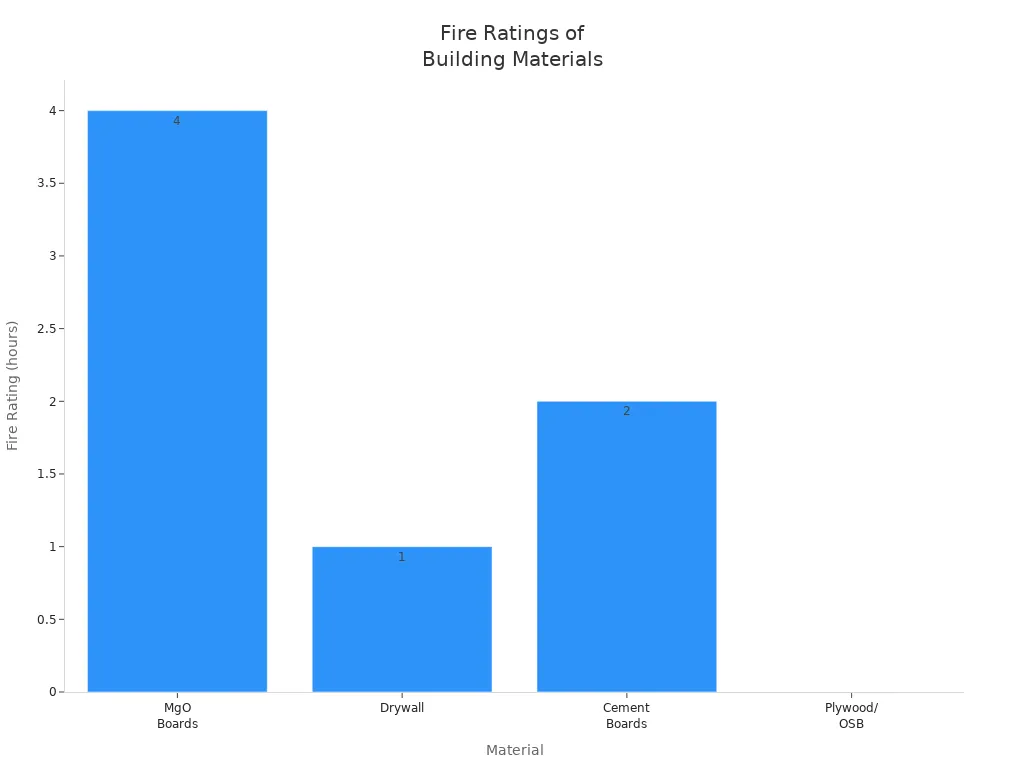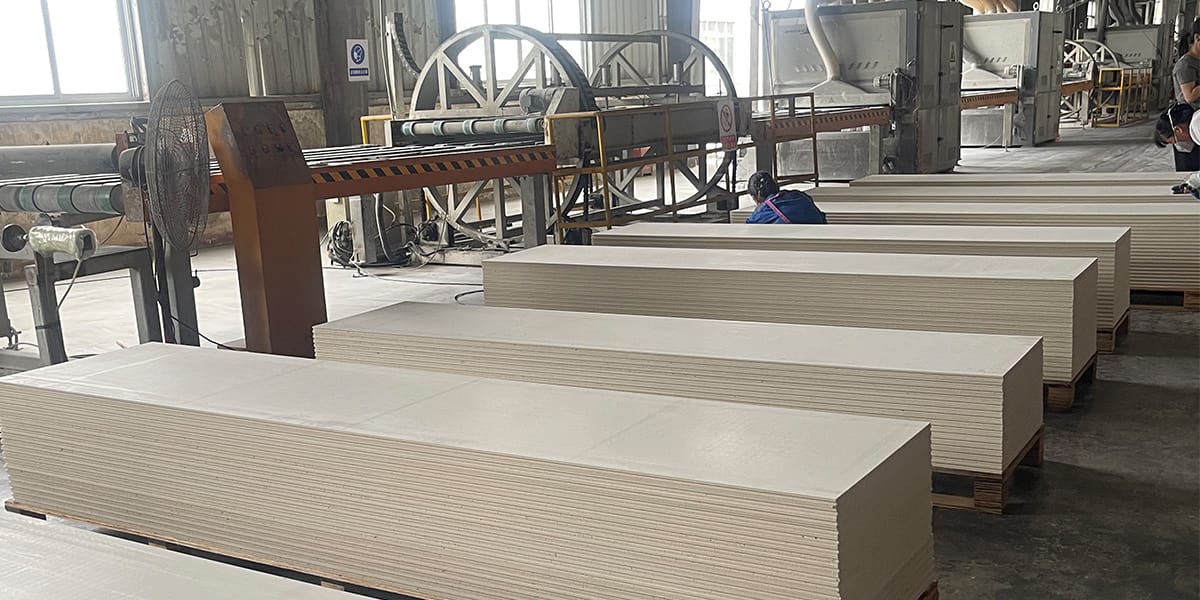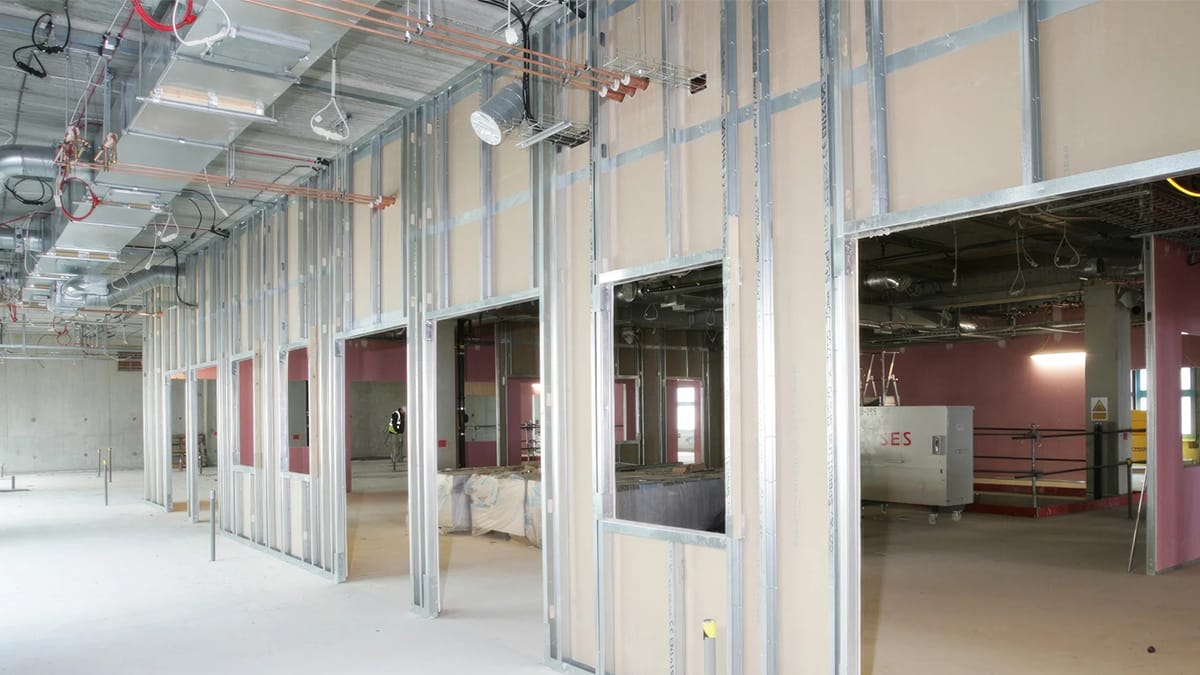
24 Sep The Use Of MgO Boards For Fire Resistant Wall Panels
Table of Contents
You want good protection for your house or business. Magnesium oxide boards give strong fire safety. They stop flames from moving to other places. Builders use magnesium oxide boards in schools, hospitals, and offices. These boards do not burn. They do not make dangerous smoke. The fire ratings show how strong they are:
Rating | |
|---|---|
30 minutes or more | 12mm board > 1 hour |
Up to 4 hours | A1 Non-Combustible |
Magnesium oxide boards help you make fire resistant wall panels. These panels keep people and things safe.
Key Takeaways
Magnesium oxide boards stop fire for up to four hours. They do not burn or make dangerous smoke.
These boards use a mix of strong materials. This makes them tough and safe from fire. They work well in schools, hospitals, and offices.
You must install MGO boards the right way. Good installation helps keep people safe and makes the boards last longer.
MGO boards help keep indoor air clean. They do not have bad chemicals like formaldehyde or asbestos.
MGO boards cost more than gypsum boards. But they are safer from fire and last longer, so they are worth the price.
What Are Magnesium Oxide Boards?
Composition and Structure
Magnesium oxide boards are used in many new buildings. These boards are made from a mix of materials. This mix makes them strong and helps stop fires. The main part is magnesium oxide. It is made when magnesium and oxygen react. Other things are added to make the board work better.
Here is what is inside magnesium oxide boards and how each part helps:
Component | Role in Fire Resistance |
|---|---|
Magnesium Oxide (MgO) | |
Magnesium Chloride (MgCl2) | Holds the board together, keeps it stable |
Perlite | Makes the board lighter and helps with heat |
Vermiculite | Grows bigger with heat, helps stop fire |
Glass Mesh | Makes the board stronger and harder to break |
Each part helps make the boards safe and strong. First, workers gather things like magnesium oxide, magnesium chloride, perlite, and glass mesh. They mix these together in a machine. This makes the mix even. The mix goes into molds to shape the boards. Pressing the mix removes air and makes the boards tougher. The boards dry and get hard after curing. Last, workers smooth, paint, and add layers to protect the boards.
Fire Resistance Features
Magnesium oxide boards help keep buildings safe from fire. These boards do not burn or make harmful smoke when hot. The boards stay strong even in very high heat. Glass fibers and silica are added to make the boards even stronger. These things help the boards handle heat and not break easily. Using these boards makes a wall that blocks heat and flames.
You can trust magnesium oxide boards for fire safety. The boards can stop fire for up to four hours. This depends on how thick the boards are and how they are put in. Builders use these boards in schools, hospitals, and offices. They pick them because they are good at stopping fire and keeping people safe.
Fire Resistant Wall Panels: How MgO Boards Work
 Mechanisms of Fire Resistance
Mechanisms of Fire Resistance
If you pick wall panels made from magnesium oxide boards, you get strong fire protection. These panels use non-combustible mgo as the main part. This means they do not catch fire or help flames move. You can count on these panels to keep your building safe, even in very hot conditions.
Magnesium oxide boards stop fire in a few ways:
They do not burn like wood or other usual materials. They also stop flames from spreading.
Non-combustible mgo does not shrink or crack when it gets very hot. This keeps fire and hot air from moving through the walls.
The boards stay strong and keep their shape, so your walls do not fall apart during a fire.
Fire-resistant mgo panels do not let out toxic smoke. This makes them safer for people inside if there is a fire.
You can see how magnesium oxide boards stop fire from spreading in wall panels in the table below:
Evidence Type | Description |
|---|---|
Flame Spread Resistance | MgO panels get a Class A flame spread rating, which means they work very well. |
Fire Endurance | MgO panels keep their shape in high heat (ASTM E119 tested). |
Installation Efficiency | You need fewer layers than with other fire resistant wall panels. |
Fire-resistant mgo panels also work well in passive fire protection systems. They act like a shield, stopping fire from moving between rooms or floors. You can use these panels in schools, hospitals, and offices to make fire safety better.
Tests show that magnesium oxide boards can take very high heat. Some panels last 2-3 hours at 800°C. Others, like Magpanel, stay strong for 30 minutes at over 750°C. These results mean you can trust fire-resistant mgo for tough fire jobs.
Certifications and Ratings
You want to know if your fire resistant wall panels are safe. Magnesium oxide boards have strong certifications and ratings. These panels often get a Class A flame spread rating. This is the best level for building materials.
The table below shows how magnesium oxide boards compare to other wall panel materials:
Property | Magnesium Oxide Boards | Gypsum Boards |
|---|---|---|
Toxic Gas Emission | No | Yes |
Fire Resistance Rating | > 2 hours | < 1 hour |
Stability at High Temperatures | Keeps strength | Burns and makes smoke |
You can see that non-combustible mgo does not make harmful smoke. This makes it safer for fire protection. The panels also stay strong in high heat, but gypsum boards can break and make smoke.
Independent fire ratings for fire resistant wall panels made with magnesium oxide boards range from 1 to 4 hours. These ratings depend on how thick the board is and how you put it in. Many panels pass the ASTM E119 test, which checks how long a wall can stop fire. Some products even get the A1 fire rating, which means they do not burn at all.
You can also look at the fire performance of different wall panel materials in the chart below:

Non-combustible mgo boards: Up to 4 hours fire rating
Cement boards: Up to 2 hours
Drywall: Up to 1 hour
Plywood/OSB: Low fire rating
Fire-resistant mgo panels give you the best fire safety for your building. You can trust these panels to keep people and things safe during a fire.
Benefits of Using MgO Boards
Safety and Durability
You want your building to last and keep everyone safe. Magnesium oxide boards give you strong protection because they do not burn or break down in a fire. When you use fire-resistant mgo panels, you help your walls stand up to high heat for a long time. These panels can resist fire for up to four hours without burning or letting out harmful gases. This makes them much safer than regular gypsum boards.
Fire-resistant mgo stays strong even when the weather changes or when the air is humid. You do not have to worry about the panels losing their fire resistance over time. Non-combustible mgo keeps its shape and does not crack, so your walls stay strong during a fire. You also meet strict fire safety standards when you use these panels in your building.
Non-combustible mgo does not catch fire, so it helps stop flames from spreading.
Fire-resistant mgo does not release toxic smoke, making it safer for people inside.
The panels work well in high-risk places like kitchens and tall buildings.
Non-combustible mgo resists moisture and mold, which helps keep the air clean and healthy.
Magnesium oxide boards also add to the strength of your building. Their durability means your walls last longer and need less repair.
Environmental and Health Advantages
You care about the environment and the health of everyone inside your building. Fire-resistant mgo panels help you create a safer and greener space. Magnesium oxide boards do not have harmful chemicals like formaldehyde or asbestos. This means you get cleaner air indoors.
Non-combustible mgo helps you earn green building certifications like LEED and BREEAM.
Fire-resistant mgo panels are friendly to the planet and safe for people.
The dense panels block noise, which can lower stress and help people feel better.
Non-combustible mgo keeps indoor temperatures steady, which is good for people with breathing problems.
Fire-resistant mgo stops mold from growing, which is important in places like hospitals and schools.
You make a smart choice for fire safety, health, and the environment when you use magnesium oxide boards in your building.
Installation and Application
Best Practices
You want your fire-resistant mgo wall panels to work well and last a long time. Good installation helps you get the best results. Start by choosing the right fasteners. Use 316-stainless steel or ceramic coated screws for strong support. When you attach the boards to wood studs, use #8 flat head screws. Keep screws at least 4 inches from corners and space them 6 inches apart around the edges. For metal frames, use #8 flat head screws with nibs and set the pneumatic pressure correctly.
Always leave a 6mm gap between the boards and the wall. This gap lets the boards expand when needed.
Begin fastening from the center of each board. Space screws 200-250mm apart. Keep screws at least 12mm from the edge and 50mm from corners.
Seal all seams with construction adhesive or joint compound. This step boosts the fire resistance of your panels.
Tip: Double-check your measurements before cutting. Using the wrong size can leave gaps that lower fire safety.
Follow the manufacturer’s instructions for every step. Skipping steps or using the wrong tools can weaken the fire-resistant mgo panels.
Compatibility and Common Issues
You can use non-combustible mgo in many building types. These boards work well with both wood and metal framing. You can use them inside or outside. Their lightweight design makes them easy to handle, but they stay strong like heavier materials. Non-combustible mgo resists moisture, so you can use it in kitchens, bathrooms, or even outside walls. You can also combine MagPanel® with insulation and other framing systems.
Micro-cracking may happen if the building settles or moves during wind or earthquakes.
Wood frames can shrink, and metal frames can expand. These changes may cause movement in the boards.
Thermal or moisture changes can also move the non-combustible mgo, leading to cracks.
You can see magnesium oxide boards used in homes, schools, and large commercial buildings. Their eco-friendly features and durability help you meet modern building needs. When you follow best practices, you get the most out of fire-resistant mgo and keep your building safe.
Limitations and Comparisons
 Drawbacks and Solutions
Drawbacks and Solutions
You should know that fire-resistant mgo panels have some drawbacks, especially in humid places. Magnesium oxide boards resist moisture well, so you can use them in kitchens and bathrooms. However, if these boards stay wet for a long time, they can expand and lose strength. This change, called hydrothermal expansion, may lower their performance in fire-resistant wall panels.
Magnesium oxide boards are moisture resistant and keep their shape in humid air.
Long exposure to water can cause them to swell and weaken.
You should protect these boards from staying wet for too long.
To avoid problems, you can follow a few simple steps:
Use sharp tools, like a utility knife or circular saw, for clean cuts.
Pick a carbide-tipped blade to reduce chipping.
Seal all joints and edges with moisture-resistant caulk or tape.
You can also choose boards made with magnesium sulfate for better moisture resistance. These steps help you keep your fire-resistant mgo panels strong and safe, even in damp areas.
Cost is another thing to think about. Magnesium oxide boards cost more than gypsum boards. Look at the table below for a quick comparison:
Board Type | Average Cost per Square Foot |
|---|---|
MgO Boards | |
Gypsum Boards | $0.40 – $1.20 |
Even though you pay more for fire-resistant mgo, you get better fire safety and longer-lasting walls.
MgO vs. Gypsum and Cement Boards
When you compare non-combustible mgo to gypsum and cement boards, you see clear differences in fire safety and performance. Fire-resistant mgo panels do not burn, even at very high temperatures. They do not make harmful smoke or gases, which keeps people safer during a fire. These panels also keep their shape and strength when exposed to heat, while gypsum boards can break down.
Board Type | Fire Resistance Rating |
|---|---|
Magnesium Oxide | Noncombustible, 1-2 hours of fire resistance |
Gypsum | Basic fire protection, needs extra treatment |
Cement | Fire-resistant, less effective than MgO |
Non-combustible mgo boards will not catch fire at temperatures up to 800°C. They do not show flames, even at 1200°C. This strong fire resistance gives you more time to leave the building safely. Fire-resistant mgo panels also do not release toxic fumes, which is important for fire safety. You can trust these panels to protect your building better than gypsum or cement boards.
When you pick magnesium oxide boards for fire-rated walls, you get great fire safety. These panels have high fire ratings and do not let flames spread fast. They also help save energy. The boards are better for the environment because they use less energy and do not have bad chemicals.
Magnesium oxide boards follow tough fire safety rules and help keep indoor air clean.
You need to install them the right way and watch for cracks at the joints.
It is smart to ask a building expert to help you choose the best fire-resistant panels for your project.
FAQ
What makes MgO boards better for fire resistance than drywall?
MgO boards do not burn or release toxic smoke. You get up to four hours of fire protection. Drywall usually lasts less than one hour and can break down in high heat.
Can you use MgO boards in wet areas like bathrooms?
Yes, you can use MgO boards in bathrooms and kitchens. They resist moisture better than drywall. You should seal all edges and joints to keep water out.
Are MgO boards safe for people with allergies?
MgO boards do not contain formaldehyde or asbestos. You get cleaner indoor air. These boards also resist mold, which helps people with allergies breathe easier.
How do you cut and install MgO boards?
You can cut MgO boards with a utility knife or a circular saw. Use stainless steel screws for installation. Always follow the manufacturer’s instructions for best results.
Do MgO boards cost more than other wall panels?
MgO boards usually cost more than gypsum boards. You pay more upfront, but you get better fire safety and longer-lasting walls. Many builders think the extra cost is worth it.

 Mechanisms of Fire Resistance
Mechanisms of Fire Resistance Drawbacks and Solutions
Drawbacks and Solutions